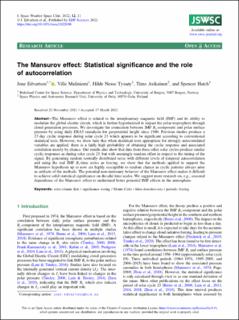| dc.contributor.author | Edvartsen, Jone Øvretvedt | |
| dc.contributor.author | Maliniemi, Ville Aleksi | |
| dc.contributor.author | Tyssøy, Hilde Nesse | |
| dc.contributor.author | Asikainen, Timo | |
| dc.contributor.author | Hatch, Spencer Mark | |
| dc.date.accessioned | 2023-03-13T10:12:28Z | |
| dc.date.available | 2023-03-13T10:12:28Z | |
| dc.date.created | 2022-06-09T17:14:26Z | |
| dc.date.issued | 2022 | |
| dc.identifier.issn | 2115-7251 | |
| dc.identifier.uri | https://hdl.handle.net/11250/3057910 | |
| dc.description.abstract | The Mansurov effect is related to the interplanetary magnetic field (IMF) and its ability to modulate the global electric circuit, which is further hypothesized to impact the polar troposphere through cloud generation processes. We investigate the connection between IMF By-component and polar surface pressure by using daily ERA5 reanalysis for geopotential height since 1980. Previous studies produce a 27-day cyclic response during solar cycle 23 which appears to be significant according to conventional statistical tests. However, we show here that when statistical tests appropriate for strongly autocorrelated variables are applied, there is a fairly high probability of obtaining the cyclic response and associated correlation merely by chance. Our results also show that data from three other solar cycles produce similar cyclic responses as during solar cycle 23, but with seemingly random offset in respect to the timing of the signal. By generating random normally distributed noise with different levels of temporal autocorrelation and using the real IMF By-time series as forcing, we show that the methods applied to support the Mansurov hypothesis up to now are highly susceptible to random chance as cyclic patterns always arise as artifacts of the methods. The potential non-stationary behavior of the Mansurov effect makes it difficult to achieve solid statistical significance on decadal time scales. We suggest more research on, e.g., seasonal dependence of the Mansurov effect to understand better potential IMF effects in the atmosphere. | en_US |
| dc.language.iso | eng | en_US |
| dc.publisher | EDP Sciences | en_US |
| dc.rights | Navngivelse 4.0 Internasjonal | * |
| dc.rights.uri | http://creativecommons.org/licenses/by/4.0/deed.no | * |
| dc.title | The Mansurov effect: Statistical significance and the role of autocorrelation | en_US |
| dc.type | Journal article | en_US |
| dc.type | Peer reviewed | en_US |
| dc.description.version | publishedVersion | en_US |
| dc.rights.holder | Copyright 2022 The Author(s) | en_US |
| dc.source.articlenumber | 11 | en_US |
| cristin.ispublished | true | |
| cristin.fulltext | original | |
| cristin.qualitycode | 1 | |
| dc.identifier.doi | 10.1051/swsc/2022008 | |
| dc.identifier.cristin | 2030589 | |
| dc.source.journal | Journal of Space Weather and Space Climate | en_US |
| dc.identifier.citation | Journal of Space Weather and Space Climate. 2022, 12, 11. | en_US |
| dc.source.volume | 12 | en_US |

